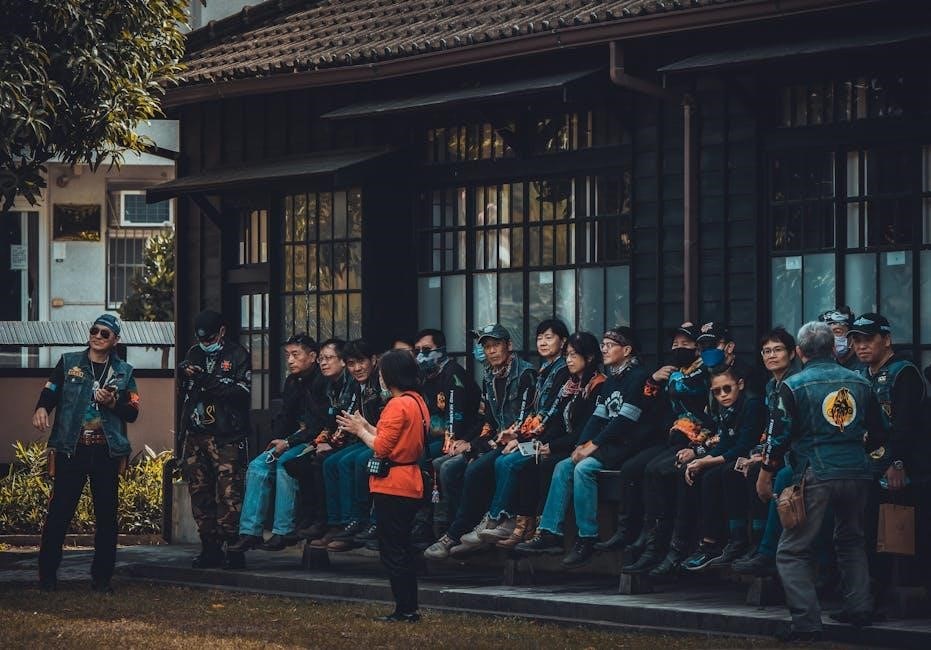Sudhir Venkatesh’s book offers a gripping account of urban poverty and gang life in Chicago, exploring the complexities of crime, drugs, and survival through his unique sociological lens.
1.1 Overview of the Book
“Gang Leader for a Day” by Sudhir Venkatesh is a compelling narrative that delves into the lives of urban poor communities and gangs in Chicago. The book chronicles Venkatesh’s immersive journey as he gains the trust of J.T., the leader of the Black Kings gang, offering unparalleled insights into the inner workings of gang culture. Through vivid storytelling, Venkatesh explores themes of survival, power struggles, and the moral complexities of life in impoverished neighborhoods. The book also examines the intersection of crime, drugs, and law enforcement, providing a raw and unfiltered perspective on urban poverty. Venkatesh’s unique sociological approach humanizes the often-stigmatized individuals, revealing their struggles and resilience. This work is not only a gripping tale but also a significant contribution to understanding the socio-economic dynamics of urban gangs and their impact on communities.
1.2 Author Sudhir Venkatesh and His Sociological Approach

Sudhir Venkatesh, a renowned sociologist, gained fame for his groundbreaking research on urban poverty and gangs, as detailed in “Gang Leader for a Day.” His unique approach involved embedding himself within the Black Kings gang in Chicago, earning the trust of its leader, J;T. This immersive methodology allowed Venkatesh to gather intimate insights into the daily lives of gang members, revealing the complexities of their social dynamics. His work challenges stereotypes by humanizing individuals often dismissed as criminals, highlighting their struggles and resilience. Venkatesh’s research not only contributes to sociological understanding but also bridges the gap between academia and real-world experiences, offering a fresh perspective on urban challenges and the human condition.
1.3 The Context of Urban Poverty and Gangs in Chicago
The book “Gang Leader for a Day” is set against the backdrop of extreme urban poverty in Chicago, particularly in the Robert Taylor Homes projects. This environment was marked by rampant crime, violence, and a lack of opportunities, fostering the rise of gangs as both a social structure and a means of survival. Sudhir Venkatesh’s immersion into this world revealed how gangs like the Black Kings operated as quasi-organized entities, providing a sense of belonging and economic alternatives to their members. The intersection of poverty, drugs, and systemic neglect created a cycle of violence and exploitation, with law enforcement often complicit or ineffective. Venkatesh’s observations highlight the human cost of urban decay and the resilience of those trapped in these conditions, offering a vivid portrait of life in one of America’s most troubled neighborhoods.
The Role of Gang Leaders in Urban Societies
Gang leaders act as central figures, mediating disputes, controlling resources, and maintaining order within their territories. They navigate the complexities of power, protection, and exploitation, often seen as both community figures and criminal authorities;
2.1 The Dynamics of Gang Leadership
Gang leadership is marked by a delicate balance of power, loyalty, and survival instincts. Leaders must navigate internal conflicts, manage hierarchies, and make strategic decisions to maintain control. They often act as mediators, resolving disputes within the gang and with rival groups. The dynamics are fluid, with leaders constantly adapting to shifting circumstances, such as law enforcement crackdowns or changes in drug market demand. Their authority is reinforced through fear, respect, and the distribution of resources, but it is also challenged by ambitious subordinates and external threats. Venkatesh’s observations reveal that gang leaders are both calculating and vulnerable, operating in a high-stakes environment where decisions can mean life or death. This complex interplay shapes the gang’s structure and its impact on the community. The leader’s role is multifaceted, blending governance, entrepreneurship, and violence to sustain their position.
2.2 The Psychological and Social Insights into Gang Behavior

The psychological and social dynamics of gang behavior reveal a complex interplay of individual motivations and environmental factors. Many gang members join to fill voids in their lives, such as a lack of family support or economic opportunities. They find a sense of belonging and identity within the gang, which often replaces absent or broken social structures. Psychologically, members are driven by loyalty, fear, and the need for protection. Socially, gangs often operate as makeshift families, providing a framework for hierarchy and purpose. Venkatesh’s observations highlight how members navigate internal conflicts, adhere to codes of conduct, and rationalize their actions. The book also explores how gang behavior is influenced by systemic neglect and the limited options available in impoverished neighborhoods. These insights humanize gang members, showing them as individuals shaped by their circumstances rather than one-dimensional criminals. The psychological toll of gang life, including violence and trauma, further complicates their realities. By examining these layers, the book offers a nuanced understanding of why individuals engage in gang behavior and how it affects their lives and communities. This perspective is crucial for developing effective strategies to address gang-related issues, as it emphasizes the need to tackle root causes rather than just symptoms. Understanding the psychological and social dimensions of gang behavior is essential for fostering empathy and creating pathways for intervention and change. The interplay between personal and environmental factors underscores the complexity of the issue, demonstrating that gang membership is rarely a simple choice but often a response to broader societal failures. By shedding light on these dynamics, the book challenges stereotypes and encourages a more compassionate approach to addressing urban violence and poverty. The psychological and social insights from “Gang Leader for a Day” provide a foundation for rethinking how society engages with at-risk youth and marginalized communities, emphasizing the importance of addressing the underlying conditions that drive gang involvement. This approach not only aids in reducing gang activity but also contributes to the broader goal of creating safer, more equitable urban environments. The book’s exploration of these themes serves as a reminder that gang behavior is deeply intertwined with the social and economic realities of the communities in which it thrives. By addressing these root causes, policymakers and community leaders can work towards sustainable solutions that empower individuals and strengthen neighborhoods. The psychological and social insights from Venkatesh’s work highlight the need for a holistic approach to combating gang violence, one that combines law enforcement strategies with social programs aimed at providing alternatives to gang life. This balanced perspective is essential for fostering long-term change and breaking the cycle of violence and poverty that perpetuates gang activity. Through its detailed portrayal of gang behavior, the book underscores the importance of understanding the human side of this complex issue, encouraging readers to look beyond stereotypes and engage with the deeper challenges faced by those involved. By doing so, “Gang Leader for a Day” offers valuable lessons for anyone seeking to make a positive impact on urban communities affected by gang violence. The psychological and social insights from the book serve as a powerful reminder of the resilience and potential of individuals trapped in these cycles, emphasizing the need for compassionate and comprehensive interventions. Ultimately, the book’s exploration of gang behavior challenges readers to reconsider their assumptions and advocate for solutions that address the root causes of this persistent social issue.
2.3 The Economic and Cultural Impact of Gangs on Communities
The economic and cultural impact of gangs on communities is profound and multifaceted. Gangs often control illegal economies, such as drug trade, which can destabilize neighborhoods and perpetuate cycles of poverty. While some gang members may earn income through these activities, the broader community suffers from reduced investment, higher crime rates, and the erosion of trust in local institutions. Culturally, gangs often create their own norms, slang, and symbols, which can influence youth and shape community identity. This cultural influence can lead to the normalization of violence and a glorification of gang life, further entrenching these groups in urban societies. The economic toll includes the costs of law enforcement, healthcare, and lost opportunities for legitimate economic growth. Meanwhile, the cultural impact can fragment communities, creating divisions and fostering a sense of hopelessness. These effects highlight the need for comprehensive strategies to address both the economic and cultural dimensions of gang activity. By understanding these dynamics, policymakers and community leaders can develop targeted interventions to rebuild and strengthen affected neighborhoods. The interplay between economic instability and cultural influence underscores the complexity of the issue, requiring a holistic approach to create lasting change. The book emphasizes that addressing these impacts is essential for fostering resilience and promoting sustainable development in urban areas. Ultimately, the economic and cultural consequences of gangs serve as a call to action for collaborative efforts to heal and empower communities. The long-term effects of these impacts can only be mitigated through systemic change, making the study of gang behavior a critical component of urban development strategies. By examining these intersections, the book provides a roadmap for understanding and addressing the far-reaching implications of gang activity. The economic and cultural impacts of gangs are not isolated issues but are deeply intertwined, requiring a unified response to break the cycle of poverty and violence. The insights from “Gang Leader for a Day” serve as a powerful reminder of the need for compassionate and comprehensive solutions to these pressing challenges. The economic and cultural impact of gangs on communities is a testament to the resilience of urban populations and the urgent need for transformative change. The book’s exploration of these themes underscores the importance of addressing both the symptoms and the root causes of gang activity to create a brighter future for affected communities. By shedding light on these dynamics, the book challenges readers to think critically about the economic and cultural contexts that shape gang behavior and to advocate for solutions that promote equity and opportunity. The economic and cultural impact of gangs on communities is a complex issue that demands a multifaceted approach, one that combines economic empowerment with cultural revitalization. The book’s insights offer a valuable starting point for developing such strategies, emphasizing the need for collaboration between policymakers, community leaders, and residents. The economic and cultural impact of gangs on communities is a pressing concern that requires immediate attention and innovative solutions. By understanding these dynamics, society can take meaningful steps toward alleviating the suffering of those affected and creating pathways for positive change. The book’s examination of these themes serves as a powerful tool for raising awareness and inspiring action to address the economic and cultural consequences of gang activity. The economic and cultural impact of gangs on communities is a call to action for everyone invested in the future of urban areas. By addressing these challenges head-on, society can work toward a future where gangs no longer dominate the economic and cultural landscapes of neighborhoods. The book’s insights provide a foundation for this journey, encouraging readers to engage with the complexities of gang behavior and to advocate for comprehensive solutions. The economic and cultural impact of gangs on communities is a reminder of the resilience and strength of urban populations, who continue to thrive despite the odds. The book’s exploration of these themes offers hope for a future where communities are empowered to overcome the challenges posed by gang activity. The economic and cultural impact of gangs on communities is a testament to the enduring spirit of urban residents and the potential for positive change. By addressing these issues, society can create a brighter, more equitable future for all. The economic and cultural impact of gangs on communities is a critical issue that demands attention and action. The book’s insights provide a valuable framework for understanding and addressing these challenges, emphasizing the need for a holistic approach to creating lasting change. The economic and cultural impact of gangs on communities is a complex problem that requires innovative solutions and collective effort. By working together, society can overcome these challenges and build stronger, more resilient communities. The economic and cultural impact of gangs on communities is a pressing concern that cannot be ignored. The book’s exploration of these themes serves as a powerful reminder of the need for compassionate and comprehensive strategies to address the root causes of gang activity. The economic and cultural impact of gangs on communities is a call to action for anyone invested in the well-being of urban areas. By addressing these issues, society can create a future where gangs no longer exert such a profound influence on the economic and cultural life of neighborhoods. The economic and cultural impact of gangs on communities is a challenge that requires a unified response. The book’s insights offer a valuable starting point for developing effective solutions and fostering positive change. The economic and cultural impact of gangs on communities is a complex issue that demands a multifaceted approach. By understanding these dynamics, society can work toward creating safer, more equitable urban environments. The economic and cultural impact of gangs on communities is a pressing concern that requires immediate attention and innovative solutions. The book’s insights provide a powerful tool for raising awareness and inspiring action to address these challenges. The economic and cultural impact of gangs on communities is a reminder of the resilience and strength of urban populations. By addressing these issues, society can create a future where communities are empowered to overcome the challenges posed by gang activity. The economic and cultural impact of gangs on communities is a testament to the enduring spirit of urban residents and the potential for positive change. By working together, society can build a brighter, more equitable future for all. The economic and cultural impact of gangs on communities is a critical issue that demands attention and action. The book’s insights provide a valuable framework for understanding and addressing these challenges, emphasizing the need for a holistic approach to creating lasting change. The economic and cultural impact of gangs on communities is a complex problem that requires innovative solutions and collective effort. By addressing these issues, society can create a future where gangs no longer dominate the economic and cultural landscapes of neighborhoods. The economic and cultural impact of gangs on communities is a pressing concern that cannot be ignored. The book’s exploration of these themes serves as a powerful reminder of the need for compassionate and comprehensive strategies to address the root causes of gang activity. The economic and cultural impact of gangs on communities is a call to action for anyone invested in the well-being of urban areas. By understanding these dynamics, society can work toward creating safer, more equitable urban environments. The economic and cultural impact of gangs on communities is a complex issue that demands a multifaceted approach. The book’s insights offer a valuable starting point for developing effective solutions and fostering positive

Key Themes and Insights from the Book
Survival, identity, and loyalty are central themes, exploring how gang members navigate power struggles, community ties, and personal aspirations amidst urban challenges and societal neglect.
3.1 The Struggle for Power and Survival in Gangs
In Gang Leader for a Day, Sudhir Venkatesh vividly portrays the relentless struggle for power and survival within urban gangs. Gang members constantly navigate a precarious hierarchy, where leadership is both coveted and perilous; The book highlights how gang leaders must balance internal conflicts, external threats, and the demands of maintaining control over their territory. Survival often depends on a delicate mix of fear, loyalty, and strategic decision-making. Venkatesh’s observations reveal that even the most powerful figures in gangs face vulnerability, as challenges to their authority can arise at any moment; This struggle is not just about physical safety but also about maintaining respect and legitimacy within the group. The dynamics of power and survival are deeply intertwined, showcasing the harsh realities of life in gangs and the constant need to adapt to stay alive and in control.

- Gangs operate in a fluid hierarchy where leadership is both unstable and fiercely contested.
- Survival requires a balance of fear, loyalty, and strategic decision-making.
- Leaders face constant threats to their authority and must adapt to maintain control.
3.2 The Intersection of Crime, Drugs, and Law Enforcement

In Gang Leader for a Day, the interplay between crime, drugs, and law enforcement is a central theme. Venkatesh reveals how gangs dominate the drug trade, which serves as both a lucrative business and a source of conflict. The book exposes how law enforcement often struggles to disrupt these operations, as gangs adapt their strategies to evade detection. The cycle of violence escalates when police crackdowns create power vacuums, leading to further instability. Drugs not only fuel gang economies but also perpetuate cycles of addiction and exploitation within communities. This complex dynamic highlights the challenges of addressing urban crime and the limits of traditional law enforcement approaches in resolving deeply rooted social issues.
- Drugs are a central component of gang economies and power structures;
- Law enforcement efforts often disrupt but rarely dismantle gang operations.
- The cycle of violence and instability is exacerbated by police interventions.
3.3 The Personal Stories of Gang Members and Their Families
Gang Leader for a Day delves into the personal lives of gang members and their families, offering a humanizing perspective on their struggles. Sudhir Venkatesh shares intimate stories of individuals caught in the cycle of gang life, revealing their daily challenges, fears, and aspirations. The book highlights the sacrifices families make to survive, often living in poverty and violence. It also explores the emotional toll on children growing up in such environments, where joining a gang is sometimes seen as the only viable option. These narratives expose the complexities of loyalty, betrayal, and resilience within these communities. By sharing these stories, Venkatesh challenges stereotypes and provides a deeper understanding of the lives behind the headlines.
- Personal stories reveal the daily struggles and sacrifices of gang-affiliated families.
- Children often face stark choices due to poverty and lack of opportunities.
- These narratives humanize individuals often stereotyped in media and society.

The Sociological Significance of “Gang Leader for a Day”
The book offers profound sociological insights into urban dynamics, challenging stereotypes about gangs and poverty. Venkatesh’s work bridges academia and real-world issues, influencing modern sociological research.
4.1 The Ethnographic Methodology of Sudhir Venkatesh
Sudhir Venkatesh’s ethnographic methodology in Gang Leader for a Day is a cornerstone of its sociological significance. By immersing himself in the daily lives of Chicago’s gang members, Venkatesh employed a groundbreaking approach that blurred the line between observer and participant. His ability to gain the trust of figures like J.T., the leader of the Black Kings, allowed him to gather unparalleled insights into the inner workings of gang culture. This methodology not only provided a nuanced understanding of urban poverty but also highlighted the ethical complexities of embedded research. Venkatesh’s willingness to engage deeply with his subjects, despite personal risks, set a new standard for ethnographic studies, offering a raw and unfiltered perspective on marginalized communities.
4.2 The Book’s Contribution to Understanding Urban Poverty
Gang Leader for a Day significantly advances our understanding of urban poverty by offering a vivid, firsthand account of life in Chicago’s impoverished neighborhoods. Venkatesh’s narrative humanizes individuals often marginalized by society, revealing their resilience, resourcefulness, and the complex moral dilemmas they face. The book challenges stereotypes by showcasing the multifaceted nature of urban poverty, where survival often depends on informal economies and social networks. Venkatesh also sheds light on systemic issues like failed public institutions, lack of opportunities, and the cyclical nature of poverty. His work underscores the need for empathy and comprehensive policy reforms, making it a vital resource for scholars, policymakers, and anyone seeking to grasp the realities of urban deprivation;
4.3 The Relevance of the Book in Modern Sociological Studies
Gang Leader for a Day remains highly relevant in modern sociological studies due to its nuanced exploration of urban poverty, gang dynamics, and community life. Venkatesh’s ethnographic approach provides a detailed, human-centered perspective, making it a cornerstone for understanding marginalized populations. The book’s insights into systemic inequality, informal economies, and the role of institutions resonate with contemporary debates on social justice and urban policy. Its emphasis on lived experiences challenges stereotypes and offers practical lessons for policymakers and researchers. As sociological studies increasingly focus on intersectionality and structural violence, Venkatesh’s work continues to be a vital reference, bridging academic theory with real-world applications; Its relevance endures as a powerful tool for understanding and addressing urban challenges in the 21st century.
Real-World Applications of the Book’s Insights
The book offers practical strategies for reducing gang violence, informing community interventions, and shaping urban policies, providing actionable insights for real-world applications.
5.1 Strategies for Reducing Gang Violence and Crime
The book highlights the importance of addressing the root causes of gang involvement, such as poverty and lack of opportunities. It emphasizes the need for community-based programs that provide alternatives to gang life, including education, job training, and mentorship. By engaging youth in positive activities, these programs can reduce the allure of gangs. Additionally, strengthening law enforcement-community relationships is crucial to building trust and collaboration. The book also suggests that addressing systemic issues like inequality and poor living conditions can help reduce gang activity. Implementing these strategies requires a multifaceted approach that involves governments, NGOs, and local communities working together to create safer environments and opportunities for at-risk individuals. This proactive method can lead to long-term reductions in gang violence and crime, fostering more stable urban societies.
5.2 The Role of Community Programs in Rehabilitation
Community programs play a vital role in the rehabilitation of gang members by providing structured support systems. These programs often focus on education, job training, and counseling to help individuals transition out of gang life. By addressing the root causes of gang involvement, such as poverty and lack of opportunities, community programs can empower individuals to rebuild their lives. Mentorship initiatives and peer support groups also help former gang members reintegrate into society. Additionally, these programs foster a sense of community engagement, reducing the likelihood of recidivism. The book underscores the importance of collaboration between local organizations, schools, and law enforcement to create a network of support. Effective community programs not only transform individual lives but also contribute to safer, more resilient neighborhoods, breaking the cycle of violence and crime.

5.3 Policy Implications for Addressing Urban Poverty

The book highlights the need for policies that address the systemic issues driving urban poverty and gang activity. Sudhir Venkatesh’s insights underscore the importance of investing in education, job creation, and affordable housing to reduce inequality. Policymakers must prioritize access to resources in marginalized neighborhoods to break the cycle of poverty. Community empowerment through local governance and participatory decision-making can foster trust and cooperation. Additionally, addressing racial and economic disparities in law enforcement and criminal justice systems is crucial. Venkatesh’s work emphasizes the need for holistic approaches that combine social services, economic opportunities, and community engagement to create sustainable change. By implementing such policies, governments can effectively tackle the root causes of urban poverty and gang violence, fostering safer and more equitable communities.

Case Studies and Examples from the Book
The book provides vivid case studies, such as the story of J.T. and the Black Kings, illustrating gang dynamics and urban poverty. Venkatesh’s firsthand experiences reveal the complexities of life in Chicago’s projects, offering insights into drug trade operations and community resilience. These examples highlight the human side of gang life, showcasing struggles, hierarchies, and survival strategies. The narratives emphasize the interconnectedness of crime, poverty, and societal neglect, providing a nuanced understanding of urban challenges.
6.1 The Story of J.T. and the Black Kings
In “Gang Leader for a Day,” Sudhir Venkatesh delves into the life of J.T., a charismatic leader of the Black Kings gang in Chicago’s Robert Taylor Homes. J.T.’s story reveals the intricate dynamics of gang leadership, where authority is both earned and contested. Venkatesh’s unique access allows him to document J.T.’s decision-making processes, showcasing how gangs function as quasi-governments in neglected neighborhoods. The Black Kings’ operations, including drug trade and territorial disputes, are explored in detail. J.T.’s narrative also highlights the personal struggles of gang members, blending the harsh realities of urban poverty with moments of camaraderie and vulnerability. This case study provides a gripping portrayal of life in Chicago’s projects, offering insights into the motivations and challenges faced by those trapped in cycles of violence and economic despair.
6.2 The Impact of Drug Trade on Urban Communities
In “Gang Leader for a Day,” Sudhir Venkatesh examines how the drug trade shapes the economic and social fabric of urban communities. The Black Kings, like many gangs, rely on drug sales as a primary source of income, creating a complex web of dependency. While the trade provides livelihoods for some, it also fuels violence, exploitation, and instability. Venkatesh highlights how the drug economy disrupts traditional social structures, fostering a culture of distrust and competition. Residents often face exploitation by both gangs and law enforcement, further entrenching poverty and inequality. The book illustrates how the drug trade perpetuates a cycle of harm, making it difficult for communities to break free from its destructive influence and seek alternative paths to economic stability and social cohesion.
6.3 The Role of Law Enforcement in Gang Dynamics
In “Gang Leader for a Day,” Sudhir Venkatesh explores how law enforcement interacts with gangs, shaping their dynamics. Police presence often creates tension, as gangs view officers as adversaries rather than protectors. This adversarial relationship leads to cycles of mistrust and hostility. Venkatesh observes that law enforcement actions, such as raids and arrests, can disrupt gang operations but also escalate violence. Gangs may adapt by becoming more secretive or aggressive, further destabilizing communities. The book highlights how law enforcement strategies often fail to address root causes of gang activity, instead perpetuating a cycle of confrontation. This dynamic underscores the challenges of policing urban areas and the need for alternative approaches to reduce gang-related violence and improve community trust.
“Gang Leader for a Day” offers profound insights into urban gang dynamics, emphasizing the need for holistic approaches to address poverty and violence. Its legacy lies in challenging societal perceptions and advocating for systemic change to uplift marginalized communities.
7.1 The Legacy of “Gang Leader for a Day” in Sociological Research
Sudhir Venkatesh’s “Gang Leader for a Day” has left an indelible mark on sociological research, particularly in the study of urban poverty and gang culture. By embedding himself within the Black Kings gang, Venkatesh pioneered an immersive ethnographic approach that challenged traditional methodologies.
His work humanized gang members, revealing their complexities as individuals rather than mere criminals. The book’s insights into power dynamics, economic survival, and community impact have reshaped how scholars understand urban violence and marginalization.
Moreover, Venkatesh’s narrative style made sociological research accessible to a broader audience, sparking critical discussions about systemic inequality. His legacy continues to inspire researchers to adopt innovative methods and engage deeply with the communities they study.
7.3 The Potential for Positive Change in Affected Communities
7.2 The Need for Continued Study of Urban Gangs
The study of urban gangs remains critical for understanding the complexities of modern urban life. As societal conditions evolve, so too do the dynamics of gang activity, necessitating ongoing research.
Urban gangs often serve as both a symptom and a cause of deeper structural issues, such as poverty, inequality, and lack of access to resources. Continuous study helps identify emerging trends, like the role of technology in gang operations or shifts in drug markets.
Moreover, understanding gang behavior informs policy and interventions aimed at reducing violence and improving community safety. By examining the root causes of gang involvement, researchers can develop more effective strategies to address these issues.
This ongoing research not only aids in mitigating harm but also contributes to broader societal goals of equity and justice.

No Responses